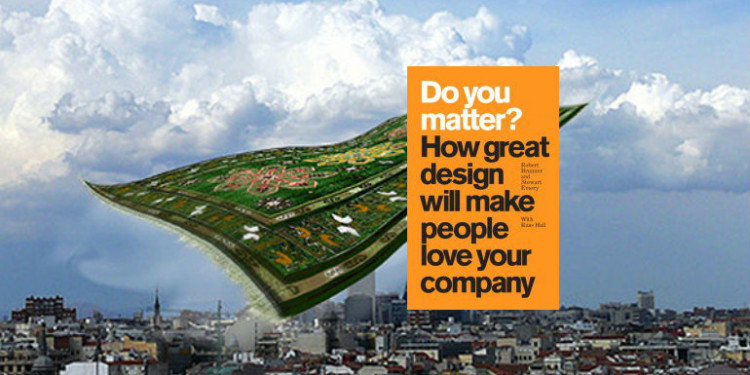Design Ideas, Not Objects

Do You Matter?: How Great Design Will Make People Love Your Company by Robert Brunner
Do You Matter? starts with the story of Steve Jobs and Apple. In contrast to the astronomic success of Apple, the authors give the example of Motorola, who was first to market with an innovative new mobile phone, the RAZR, but who were unable to maintain a market lead or continue a trajectory of innovation. Brunner and Emery point out that Motorola did not have a design culture and could not move beyond a single successful product, only applying a “veneer of the design” to future products. To be successful requires a broad, not narrow, definition of design.
Great products are about ideas; they are not just objects
Ironically enough, the Motorola team was determined to “make no compromises” and “be the king of thin“, which at that time was a tall challenge given the state of mobile phones (Nokia was the market leader in flip phones). The RAZR was considered more than just a cell phone–the first device which transcended objecthood and pure utility. Unfortunately, the product didn’t go far enough and missed the coming wave of software and services that Apple rode.
Robert Brunner was the head of Industrial Design for Apple from 1989 to 1997 and is famous for being the guy who hired Jonathan Ive. He also designed the Pill Speaker. In its “Oral History of Apple Computer“, Fast Company Design says “much of the critical design work that led to Apple’s resurgence started while Jobs was running Pixar and NeXT [in 1985 through 1997].” This was the time that Brunner was head of Industrial Design at Apple.
Motorola was purchased by Google in mid-2011 and, in August 2013, introduced the Moto X phone. This phone is fully integrated with Google services and is intended as a gateway to Google products and advertising. Interestingly, this product matches many of the attributes that the authors of Do You Matter? set forth as exemplifying a design driven company.
The difference between a great product and a merely good product is that a great product embodies an idea that people can understand and learn about–an idea that grows in their minds, one they emotionally engage with.
In the video below, Brunner sums up his philosophy succinctly: ““Really great stuff embodies an idea. And it’s an idea people can relate to. If you’ve done a really good job, that thing, that object you created, is a portal into a broader experience.”
Products as portals
Effective design establishes the emotional relationship you develop with a brand through the total experience to which a service or product provides a portal
If you take away iTunes, the $.99 pricing model, the Apple store, the representation of the product in the media, and the packaging, an iPod becomes just a beautiful object. It’s no longer a full product–it no longer embodies an idea the people connect with. Brunner calls great products like the iPod “portals into a broader experience.” The iPod is a gateway into your “music and entertainment universe”–the broader experience of music and media. The entire experience of a physical product includes everything from the retail experience (acquisition) to disposal and/or upgrade. The underlying idea of a product is what Brunner calls “an editorial thread” that shapes all touch points and aspects of the customer’s experience of the product. The book says that Apple did not invent what became the iPod. Instead, Apple developed the iPod as a portal to an incredibly valuable ongoing consumer experience.
Robert Brunner writes from a branding and interaction design perspective–he does not focus on the problem to be solved, or the “job to be done”. For him, the essential value in products comes from the emotional connection beyond the physical object. This perspective is common among industrial designers who must place physical objects in market. It’s less typical to find software companies, which tend to focus on user interface experience.
Emotion creates strong brands
You must continually contemplate how engaging hearts and minds is part of your total concept of product design
To achieve a strong emotional connection with your customer through your products and services, begin by asking yourself: how do I want this person to feel when they take delivery of the product…when they use the service?
The way to establish this connection is to build a whole product–the entire customer experience from acquisition, management, usage, issue resolution, upgrade, and disposal. If the total set of customer touch points that encompass your customer’s experience with your company and your product create a positive experience, you have an affirmative answer to: “do you matter?”. Brunner’s point is that all this must be designed. Making a beautiful object is not enough. A holistic approach to design, specifically the intersection of industrial design and interaction design, is what can create a product which is a “portal to a broader experience”.
Brunner’s goal is to create a relationship beyond functionality and determine what is meaningful for people about the product. That meaning is the key to the “gut feeling” that Brunner sees at the heart of a brand. He says that “when more than one person has the same feeling [about your product], you have a brand.”
Do You Matter?
Ask yourself this: would your customers shed any tears if you were gone tomorrow?
Will anyone be sad if your company or product were to cease to exist? This question cuts to the heart of business success and longevity. An affirmative answer relies on an emotional connection between your product and your customers. If you have been successful in establishing an emotional resonance in your customers, they will be sad if your company ceases to exist. Brunner points out that many companies survive without this connection, or even with a loose connection, but that’s far from achieving their potential. Brunner encourages companies to ask: “what is meaningful for people about this object?” If you make a connection to your customer’s emotional needs and desires, you will matter.
One product that mattered so much that it came back from the dead was Twinkies. There was such an outcry at the demise of this loved product that it not only has been revived, there are now homemade Twinkie machines available. That is the ultimate closeness to customers–right in their kitchen!
Customer touch points
You have to look at your business from beginning to end and see how it all relates to your customer
For Brunner, design is “the overt, thoughtful development of interactive touch points between you and your customer.” This thoughtful development yields lower marketing costs because the product speaks for itself in a way and exists within a meaningful emotional context. There is less need to talk and explain because just experiencing the product transmits the benefits and establishes the relationship. Creating a direct relationship with your customer that does not require live interactions with your staff is very valuable.
When people will pay you a premium for an experience you have designed for them and that they have connected with and value, it’s the only thing your competitor can’t replicate instantly.
A great customer experience requires a large investment in time and money, but also in attention, observation, trial and error, and iteration. This cannot be done overnight. It’s not a process improvement–it’s a culture change and mindset.
Brunner notes that “One terrifyingly real thing for companies such as Dell is that the minute they have to get a person involved with the customer, they lose all the profit on many products.” This often works against encouraging customer engagement and leads to isolating and separating technologies and processes that stand between a company and its customers.
Designing ideas
Design means you are overtly creating, developing, prototyping, and manufacturing with customer emotion in mind
Designing ideas, rather than just objects, creates guiding principles and experiential goals which are expressed as a design language. That design language can then be used to ensure that the entire “customer experience supply chain” is congruent. This achieves the emotional connection that establishes the brand and makes the customer care if your company lives or dies. A great customer experience is very difficult to replicate by competitors and can even resurrect products from beyond the grave.






